
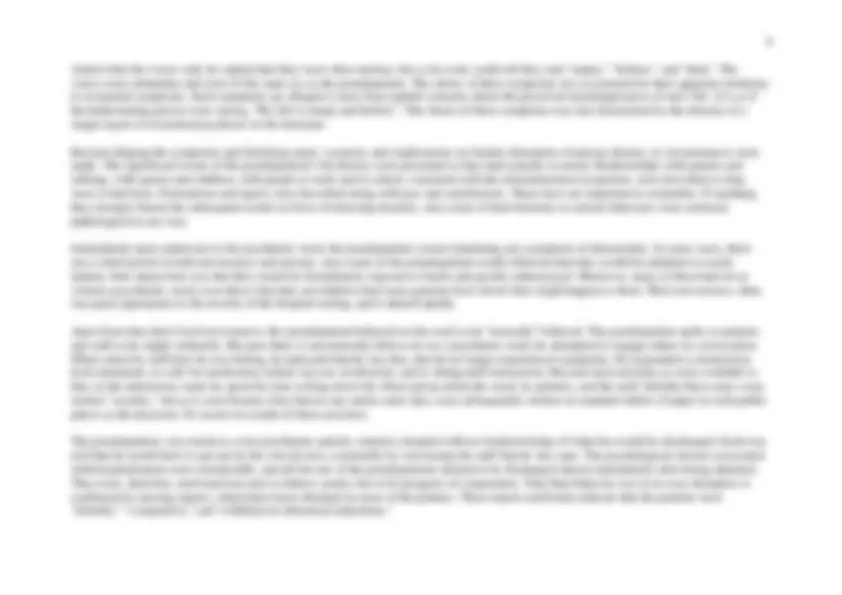
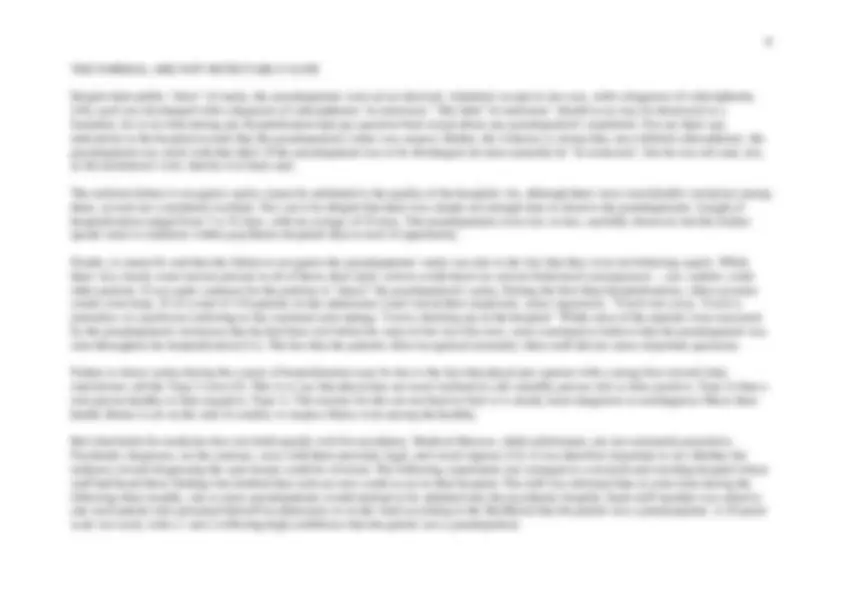
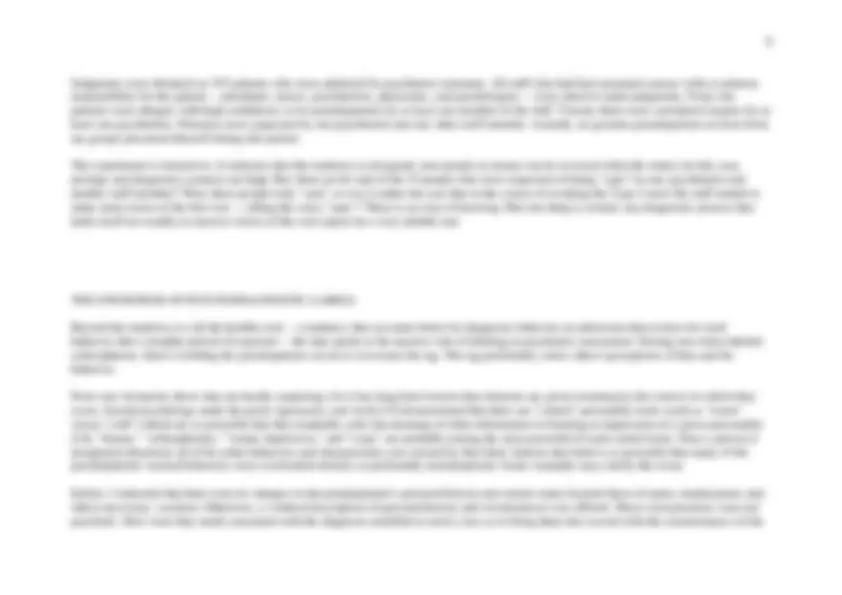
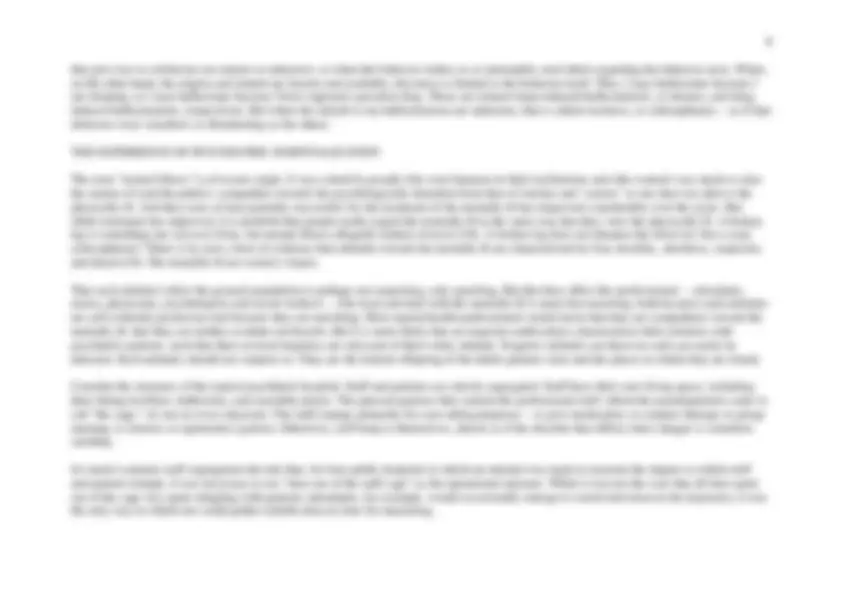
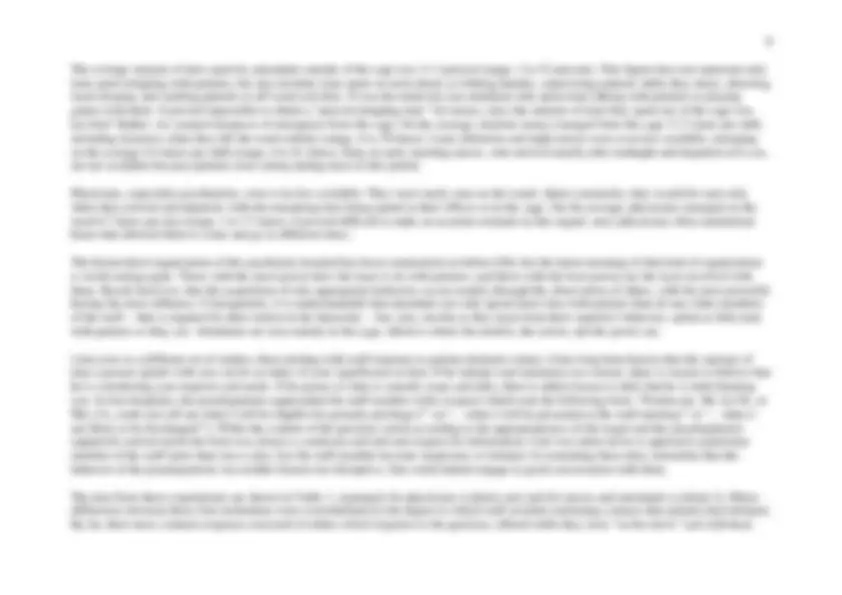
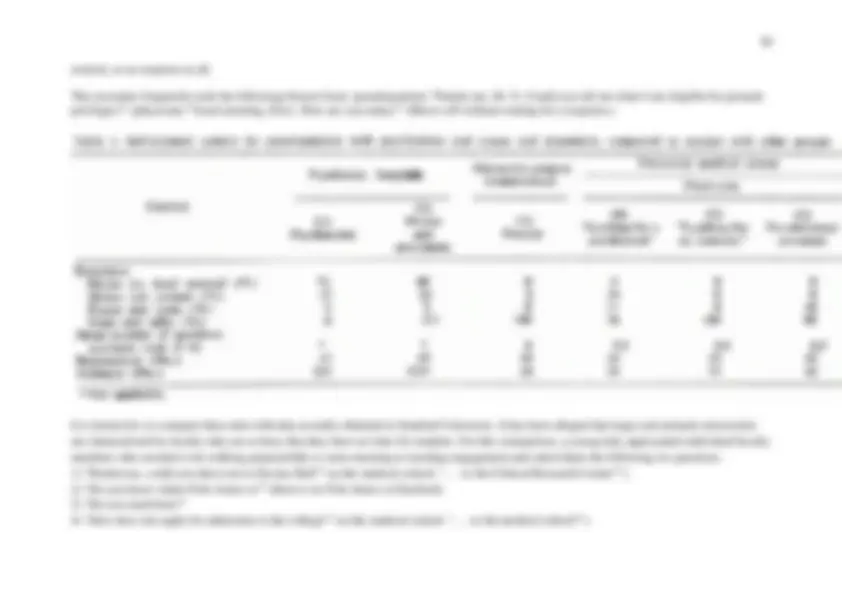
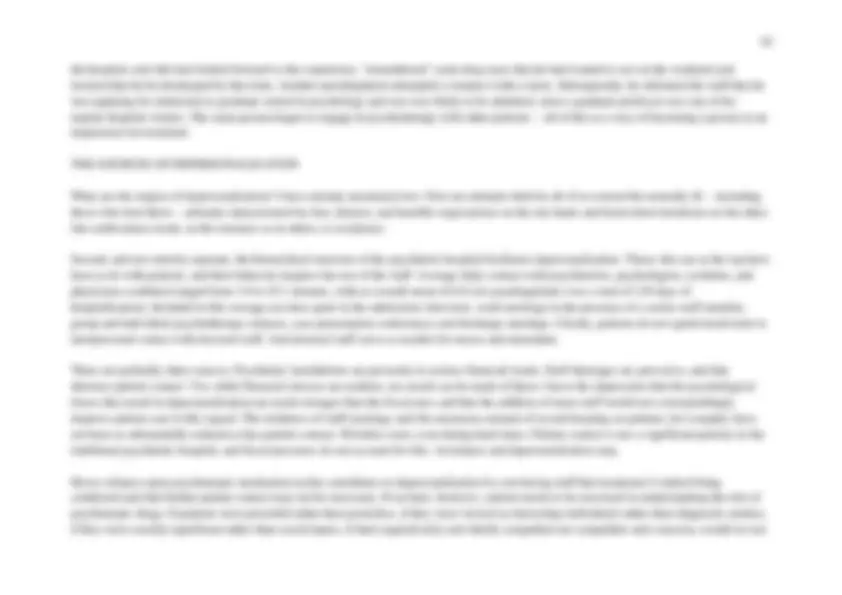
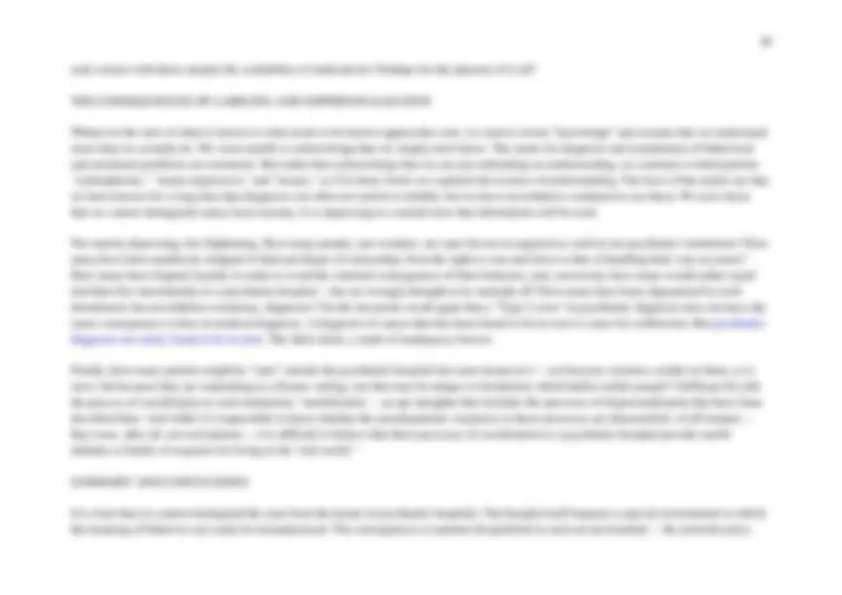
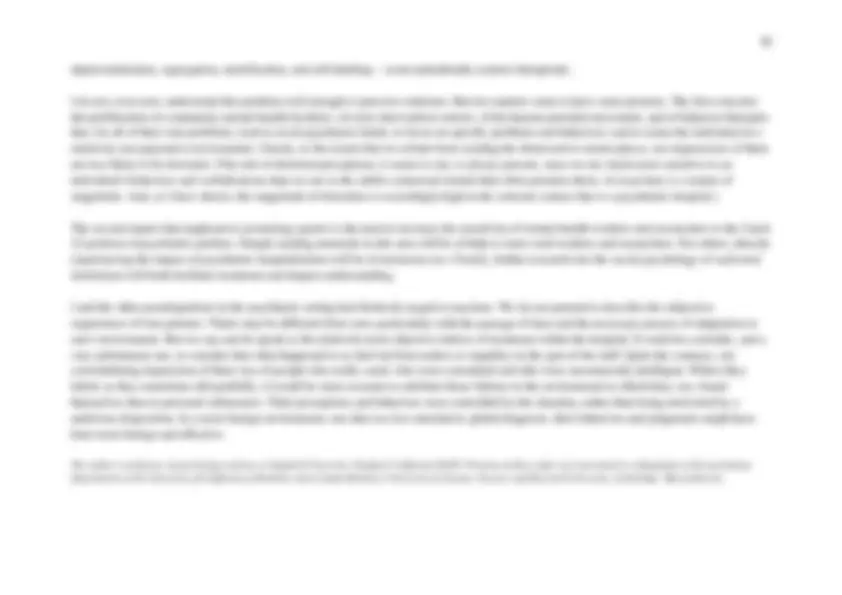



Study with the several resources on Docsity

Earn points by helping other students or get them with a premium plan


Prepare for your exams
Study with the several resources on Docsity

Earn points to download
Earn points by helping other students or get them with a premium plan
Community
Ask the community for help and clear up your study doubts
Discover the best universities in your country according to Docsity users
Free resources
Download our free guides on studying techniques, anxiety management strategies, and thesis advice from Docsity tutors
The hospital itself imposes a special environment in which the meaning of behavior can easily be misunderstood.
Typology: Study notes
1 / 18

This page cannot be seen from the preview
Don't miss anything!











Originally published in Science , New Series, Vol. 179, No. 4070. (Jan. 19, 1973), pp. 250-258.
If sanity and insanity exist, how shall we know them?
The question is neither capricious nor itself insane. However much we may be personally convinced that we can tell the normal from the abnormal, the evidence is simply not compelling. It is commonplace, for example, to read about murder trials wherein eminent psychiatrists for the defense are contradicted by equally eminent psychiatrists for the prosecution on the matter of the defendant's sanity. More generally, there are a great deal of conflicting data on the reliability, utility, and meaning of such terms as "sanity," "insanity," "mental illness," and "schizophrenia" [1]. Finally, as early as 1934, {Ruth} Benedict suggested that normality and abnormality are not universal. [2] What is viewed as normal in one culture may be seen as quite aberrant in another. Thus, notions of normality and abnormality may not be quite as accurate as people believe they are.
To raise questions regarding normality and abnormality is in no way to question the fact that some behaviors are deviant or odd. Murder is deviant. So, too, are hallucinations. Nor does raising such questions deny the existence of the personal anguish that is often associated with "mental illness." Anxiety and depression exist. Psychological suffering exists. But normality and abnormality, sanity and insanity, and the diagnoses that flow from them may be less substantive than many believe them to be.
At its heart, the question of whether the sane can be distinguished from the insane (and whether degrees of insanity can be distinguished from each other) is a simple matter: Do the salient characteristics that lead to diagnoses reside in the patients themselves or in the environments and contexts in which observers find them? From Bleuler, through Kretchmer, through the formulators of the recently revised Diagnostic and Statistical Manual of the American Psychiatric Association, the belief has been strong that patients present symptoms, that those symptoms can be categorized, and, implicitly, that the sane are distinguishable from the insane. More recently, however, this belief has been questioned. Based in part on theoretical and anthropological considerations, but also on philosophical, legal, and therapeutic ones, the view has grown that psychological categorization of mental illness is useless at best and downright harmful, misleading, and pejorative at worst. Psychiatric diagnoses, in this view, are in the minds of observers and are not valid summaries of characteristics displayed by the observed. [3-5]
Gains can be made in deciding which of these is more nearly accurate by getting normal people (that is, people who do not have, and have never suffered, symptoms of serious psychiatric disorders) admitted to psychiatric hospitals and then determining whether they were discovered to be
sane and, if so, how. If the sanity of such pseudopatients were always detected, there would be prima facie evidence that a sane individual can be distinguished from the insane context in which he is found. Normality (and presumably abnormality) is distinct enough that it can be recognized wherever it occurs, for it is carried within the person. If, on the other hand, the sanity of the pseudopatients were never discovered, serious difficulties would arise for those who support traditional modes of psychiatric diagnosis. Given that the hospital staff was not incompetent, that the pseudopatient had been behaving as sanely as he had been out of the hospital, and that it had never been previously suggested that he belonged in a psychiatric hospital, such an unlikely outcome would support the view that psychiatric diagnosis betrays little about the patient but much about the environment in which an observer finds him.
This article describes such an experiment. Eight sane people gained secret admission to 12 different hospitals [6]. Their diagnostic experiences constitute the data of the first part of this article; the remainder is devoted to a description of their experiences in psychiatric institutions. Too few psychiatrists and psychologists, even those who have worked in such hospitals, know what the experience is like. They rarely talk about it with former patients, perhaps because they distrust information coming from the previously insane. Those who have worked in psychiatric hospitals are likely to have adapted so thoroughly to the settings that they are insensitive to the impact of that experience. And while there have been occasional reports of researchers who submitted themselves to psychiatric hospitalization [7], these researchers have commonly remained in the hospitals for short periods of time, often with the knowledge of the hospital staff. It is difficult to know the extent to which they were treated like patients or like research colleagues. Nevertheless, their reports about the inside of the psychiatric hospital have been valuable. This article extends those efforts.
PSEUDOPATIENTS AND THEIR SETTINGS
The eight pseudopatients were a varied group. One was a psychology graduate student in his 20's. The remaining seven were older and "established." Among them were three psychologists, a pediatrician, a psychiatrist, a painter, and a housewife. Three pseudopatients were women, five were men. All of them employed pseudonyms, lest their alleged diagnoses embarrass them later. Those who were in mental health professions alleged another occupation in order to avoid the special attentions that might be accorded by staff, as a matter of courtesy or caution, to ailing colleagues.[8] With the exception myself (I was the first pseudopatient and my presence was known to the hospital administration and chief psychologist and, so far as I can tell, to them alone), the presence of pseudopatients and the nature of the research program was not known to the hospital staffs.[9]
The settings are similarly varied. In order to generalize the findings, admission into a variety of hospitals was sought. The 12 hospitals in the sample were located in five different states on the East and West coasts. Some were old and shabby, some were quite new. Some had good staff- patient ratios, others were quite understaffed. Only one was a strict private hospital. All of the others were supported by state or federal funds or, in one instance, by university funds.
After calling the hospital for an appointment, the pseudopatient arrived at the admissions office complaining that he had been hearing voices.
Despite their public "show" of sanity, the pseudopatients were never detected. Admitted, except in one case, with a diagnosis of schizophrenia [10], each was discharged with a diagnosis of schizophrenia "in remission." The label "in remission" should in no way be dismissed as a formality, for at no time during any hospitalization had any question been raised about any pseudopatient's simulation. Nor are there any indications in the hospital records that the pseudopatient's status was suspect. Rather, the evidence is strong that, once labeled schizophrenic, the pseudopatient was stuck with that label. If the pseudopatient was to be discharged, he must naturally be "in remission"; but he was not sane, nor, in the institution's view, had he ever been sane.
The uniform failure to recognize sanity cannot be attributed to the quality of the hospitals, for, although there were considerable variations among them, several are considered excellent. Nor can it be alleged that there was simply not enough time to observe the pseudopatients. Length of hospitalization ranged from 7 to 52 days, with an average of 19 days. The pseudopatients were not, in fact, carefully observed, but this failure speaks more to traditions within psychiatric hospitals than to lack of opportunity.
Finally, it cannot be said that the failure to recognize the pseudopatients' sanity was due to the fact that they were not behaving sanely. While there was clearly some tension present in all of them, their daily visitors could detect no serious behavioral consequences -- nor, indeed, could other patients. It was quite common for the patients to "detect" the pseudopatient's sanity. During the first three hospitalizations, when accurate counts were kept, 35 of a total of 118 patients on the admissions ward voiced their suspicions, some vigorously. "You're not crazy. You're a journalist, or a professor (referring to the continual note-taking). You're checking up on the hospital." While most of the patients were reassured by the pseudopatient's insistence that he had been sick before he came in but was fine now, some continued to believe that the pseudopatient was sane throughout his hospitalization [11]. The fact that the patients often recognized normality when staff did not raises important questions.
Failure to detect sanity during the course of hospitalization may be due to the fact that physicians operate with a strong bias toward what statisticians call the Type 2 error [5]. This is to say that physicians are more inclined to call a healthy person sick (a false positive, Type 2) than a sick person healthy (a false negative, Type 1). The reasons for this are not hard to find: it is clearly more dangerous to misdiagnose illness than health. Better to err on the side of caution, to suspect illness even among the healthy.
But what holds for medicine does not hold equally well for psychiatry. Medical illnesses, while unfortunate, are not commonly pejorative. Psychiatric diagnoses, on the contrary, carry with them personal, legal, and social stigmas [12]. It was therefore important to see whether the tendency toward diagnosing the sane insane could be reversed. The following experiment was arranged at a research and teaching hospital whose staff had heard these findings but doubted that such an error could occur in their hospital. The staff was informed that at some time during the following three months, one or more pseudopatients would attempt to be admitted into the psychiatric hospital. Each staff member was asked to rate each patient who presented himself at admissions or on the ward according to the likelihood that the patient was a pseudopatient. A 10-point scale was used, with a 1 and 2 reflecting high confidence that the patient was a pseudopatient.
Judgments were obtained on 193 patients who were admitted for psychiatric treatment. All staff who had had sustained contact with or primary responsibility for the patient -- attendants, nurses, psychiatrists, physicians, and psychologists -- were asked to make judgments. Forty-one patients were alleged, with high confidence, to be pseudopatients by at least one member of the staff. Twenty-three were considered suspect by at least one psychiatrist. Nineteen were suspected by one psychiatrist and one other staff member. Actually, no genuine pseudopatient (at least from my group) presented himself during this period.
The experiment is instructive. It indicates that the tendency to designate sane people as insane can be reversed when the stakes (in this case, prestige and diagnostic acumen) are high. But what can be said of the 19 people who were suspected of being "sane" by one psychiatrist and another staff member? Were these people truly "sane" or was it rather the case that in the course of avoiding the Type 2 error the staff tended to make more errors of the first sort -- calling the crazy "sane"? There is no way of knowing. But one thing is certain: any diagnostic process that lends itself too readily to massive errors of this sort cannot be a very reliable one.
Beyond the tendency to call the healthy sick -- a tendency that accounts better for diagnostic behavior on admission than it does for such behavior after a lengthy period of exposure -- the data speak to the massive role of labeling in psychiatric assessment. Having once been labeled schizophrenic, there is nothing the pseudopatient can do to overcome the tag. The tag profoundly colors others' perceptions of him and his behavior.
From one viewpoint, these data are hardly surprising, for it has long been known that elements are given meaning by the context in which they occur. Gestalt psychology made the point vigorously, and Asch [13] demonstrated that there are "central" personality traits (such as "warm" versus "cold") which are so powerful that they markedly color the meaning of other information in forming an impression of a given personality [14]. "Insane," "schizophrenic," "manic-depressive," and "crazy" are probably among the most powerful of such central traits. Once a person is designated abnormal, all of his other behaviors and characteristics are colored by that label. Indeed, that label is so powerful that many of the pseudopatients' normal behaviors were overlooked entirely or profoundly misinterpreted. Some examples may clarify this issue.
Earlier, I indicated that there were no changes in the pseudopatient's personal history and current status beyond those of name, employment, and, where necessary, vocation. Otherwise, a veridical description of personal history and circumstances was offered. Those circumstances were not psychotic. How were they made consonant with the diagnosis modified in such a way as to bring them into accord with the circumstances of the
that are sometimes correlated with schizophrenia.
One tacit characteristic of psychiatric diagnosis is that it locates the sources of aberration within the individual and only rarely within the complex of stimuli that surrounds him. Consequently, behaviors that are stimulated by the environment are commonly misattributed to the patient's disorder. For example, one kindly nurse found a pseudopatient pacing the long hospital corridors. "Nervous, Mr. X?" she asked. "No, bored," he said.
The notes kept by pseudopatients are full of patient behaviors that were misinterpreted by well-intentioned staff. Often enough, a patient would go "berserk" because he had, wittingly or unwittingly, been mistreated by, say, an attendant. A nurse coming upon the scene would rarely inquire even cursorily into the environmental stimuli of the patient's behavior. Rather, she assumed that his upset derived from his pathology, not from his present interactions with other staff members. Occasionally, the staff might assume that the patient's family (especially when they had recently visited) or other patients had stimulated the outburst. But never were the staff found to assume that one of themselves or the structure of the hospital had anything to do with a patient's behavior. One psychiatrist pointed to a group of patients who were sitting outside the cafeteria entrance half an hour before lunchtime. To a group of young residents he indicated that such behavior was characteristic of the oral-acquisitive nature of the syndrome. It seemed not to occur to him that there were very few things to anticipate in a psychiatric hospital besides eating.
A psychiatric label has a life and an influence of its own. Once the impression has been formed that the patient is schizophrenic, the expectation is that he will continue to be schizophrenic. When a sufficient amount of time has passed, during which the patient has done nothing bizarre, he is considered to be in remission and available for discharge. But the label endures beyond discharge, with the unconfirmed expectation that he will behave as a schizophrenic again. Such labels, conferred by mental health professionals, are as influential on the patient as they are on his relatives and friends, and it should not surprise anyone that the diagnosis acts on all of them as a self-fulfilling prophecy. Eventually, the patient himself accepts the diagnosis, with all of its surplus meanings and expectations, and behaves accordingly [5].
The inferences to be made from these matters are quite simple. Much as Zigler and Phillips have demonstrated that there is enormous overlap in the symptoms presented by patients who have been variously diagnosed [16], so there is enormous overlap in the behaviors of the sane and the insane. The sane are not "sane" all of the time. We lose our tempers "for no good reason." We are occasionally depressed or anxious, again for no good reason. And we may find it difficult to get along with one or another person -- again for no reason that we can specify. Similarly, the insane are not always insane. Indeed, it was the impression of the pseudopatients while living with them that they were sane for long periods of time -- that the bizarre behaviors upon which their diagnoses were allegedly predicated constituted only a small fraction of their total behavior. If it makes no sense to label ourselves permanently depressed on the basis of an occasional depression, then it takes better evidence than is presently available to label all patients insane or schizophrenic on the basis of bizarre behaviors or cognitions. It seems more useful, as Mischel [17] has pointed out, to limit our discussions to behaviors, the stimuli that provoke them, and their correlates.
It is not known why powerful impressions of personality traits, such as "crazy" or "insane," arise. Conceivably, when the origins of and stimuli
that give rise to a behavior are remote or unknown, or when the behavior strikes us as immutable, trait labels regarding the behavior arise. When, on the other hand, the origins and stimuli are known and available, discourse is limited to the behavior itself. Thus, I may hallucinate because I am sleeping, or I may hallucinate because I have ingested a peculiar drug. These are termed sleep-induced hallucinations, or dreams, and drug- induced hallucinations, respectively. But when the stimuli to my hallucinations are unknown, that is called craziness, or schizophrenia -- as if that inference were somehow as illuminating as the others.
THE EXPERIENCE OF PSYCHIATRIC HOSPITALIZATION
The term "mental illness" is of recent origin. It was coined by people who were humane in their inclinations and who wanted very much to raise the station of (and the public's sympathies toward) the psychologically disturbed from that of witches and "crazies" to one that was akin to the physically ill. And they were at least partially successful, for the treatment of the mentally ill has improved considerably over the years. But while treatment has improved, it is doubtful that people really regard the mentally ill in the same way that they view the physically ill. A broken leg is something one recovers from, but mental illness allegedly endures forever [18]. A broken leg does not threaten the observer, but a crazy schizophrenic? There is by now a host of evidence that attitudes toward the mentally ill are characterized by fear, hostility, aloofness, suspicion, and dread [19]. The mentally ill are society's lepers.
That such attitudes infect the general population is perhaps not surprising, only upsetting. But that they affect the professionals -- attendants, nurses, physicians, psychologists and social workers -- who treat and deal with the mentally ill is more disconcerting, both because such attitudes are self-evidently pernicious and because they are unwitting. Most mental health professionals would insist that they are sympathetic toward the mentally ill, that they are neither avoidant nor hostile. But it is more likely that an exquisite ambivalence characterizes their relations with psychiatric patients, such that their avowed impulses are only part of their entire attitude. Negative attitudes are there too and can easily be detected. Such attitudes should not surprise us. They are the natural offspring of the labels patients wear and the places in which they are found.
Consider the structure of the typical psychiatric hospital. Staff and patients are strictly segregated. Staff have their own living space, including their dining facilities, bathrooms, and assembly places. The glassed quarters that contain the professional staff, which the pseudopatients came to call "the cage," sit out on every dayroom. The staff emerge primarily for care-taking purposes -- to give medication, to conduct therapy or group meeting, to instruct or reprimand a patient. Otherwise, staff keep to themselves, almost as if the disorder that afflicts their charges is somehow catching.
So much is patient-staff segregation the rule that, for four public hospitals in which an attempt was made to measure the degree to which staff and patients mingle, it was necessary to use "time out of the staff cage" as the operational measure. While it was not the case that all time spent out of the cage was spent mingling with patients (attendants, for example, would occasionally emerge to watch television in the dayroom), it was the only way in which one could gather reliable data on time for measuring.
averted, or no response at all.
The encounter frequently took the following bizarre form: (pseudopatient) "Pardon me, Dr. X. Could you tell me when I am eligible for grounds privileges?" (physician) "Good morning, Dave. How are you today?" (Moves off without waiting for a response.)
It is instructive to compare these data with data recently obtained at Stanford University. It has been alleged that large and eminent universities
are characterized by faculty who are so busy that they have no time for students. For this comparison, a young lady approached individual faculty
members who seemed to be walking purposefully to some meeting or teaching engagement and asked them the following six questions.
"Pardon me, could you direct me to Encina Hall?" (at the medical school: "... to the Clinical Research Center?").
"Do you know where Fish Annex is?" (there is no Fish Annex at Stanford).
"Do you teach here?"
"How does one apply for admission to the college?" (at the medical school: "... to the medical school?").
"Is it difficult to get in?"
"Is there financial aid?"
Without exception, as can be seen in Table 1 (column 3), all of the questions were answered. No matter how rushed they were, all respondents
not only maintained eye contact, but stopped to talk. Indeed, many of the respondents went out of their way to direct or take the questioner to the office she was seeking, to try to locate "Fish Annex," or to discuss with her the possibilities of being admitted to the university.
Similar data, also shown in Table 1 (columns 4, 5, and 6), were obtained in the hospital. Here too, the young lady came prepared with six
questions. After the first question, however, she remarked to 18 of her respondents (column 4), "I'm looking for a psychiatrist," and to 15 others
(column 5), "I'm looking for an internist." Ten other respondents received no inserted comment (column 6). The general degree of cooperative
responses is considerably higher for these university groups than it was for pseudopatients in psychiatric hospitals. Even so, differences are
apparent within the medical school setting. Once having indicated that she was looking for a psychiatrist, the degree of cooperation elicited was less than when she sought an internist.
Eye contact and verbal contact reflect concern and individuation; their absence, avoidance and depersonalization. The data I have presented do
not do justice to the rich daily encounters that grew up around matters of depersonalization and avoidance. I have records of patients who were
beaten by staff for the sin of having initiated verbal contact. During my own experience, for example, one patient was beaten in the presence of
other patients for having approached an attendant and told him, "I like you." Occasionally, punishment meted out to patients for misdemeanors seemed so excessive that it could not be justified by the most rational interpretations of psychiatric cannon. Nevertheless, they appeared to go
unquestioned. Tempers were often short. A patient who had not heard a call for medication would be roundly excoriated, and the morning
attendants would often wake patients with, "Come on, you m-----f-----s, out of bed!"
Neither anecdotal nor "hard" data can convey the overwhelming sense of powerlessness which invades the individual as he is continually
exposed to the depersonalization of the psychiatric hospital. It hardly matters which psychiatric hospital -- the excellent public ones and the very
plush private hospital were better than the rural and shabby ones in this regard, but, again, the features that psychiatric hospitals had in common
overwhelmed by far their apparent differences.
Powerlessness was evident everywhere.
the hospital, and who had looked forward to the experience, "remembered" some drag races that he had wanted to see on the weekend and
insisted that he be discharged by that time. Another pseudopatient attempted a romance with a nurse. Subsequently, he informed the staff that he
was applying for admission to graduate school in psychology and was very likely to be admitted, since a graduate professor was one of his
regular hospital visitors. The same person began to engage in psychotherapy with other patients -- all of this as a way of becoming a person in an impersonal environment.
What are the origins of depersonalization? I have already mentioned two. First are attitudes held by all of us toward the mentally ill -- including
those who treat them -- attitudes characterized by fear, distrust, and horrible expectations on the one hand, and benevolent intentions on the other.
Our ambivalence leads, in this instance as in others, to avoidance.
Second, and not entirely separate, the hierarchical structure of the psychiatric hospital facilitates depersonalization. Those who are at the top have
least to do with patients, and their behavior inspires the rest of the staff. Average daily contact with psychiatrists, psychologists, residents, and
physicians combined ranged form 3.9 to 25.1 minutes, with an overall mean of 6.8 (six pseudopatients over a total of 129 days of
hospitalization). Included in this average are time spent in the admissions interview, ward meetings in the presence of a senior staff member,
group and individual psychotherapy contacts, case presentation conferences and discharge meetings. Clearly, patients do not spend much time in
interpersonal contact with doctoral staff. And doctoral staff serve as models for nurses and attendants.
There are probably other sources. Psychiatric installations are presently in serious financial straits. Staff shortages are pervasive, and that
shortens patient contact. Yet, while financial stresses are realities, too much can be made of them. I have the impression that the psychological
forces that result in depersonalization are much stronger than the fiscal ones and that the addition of more staff would not correspondingly
improve patient care in this regard. The incidence of staff meetings and the enormous amount of record-keeping on patients, for example, have
not been as substantially reduced as has patient contact. Priorities exist, even during hard times. Patient contact is not a significant priority in the
traditional psychiatric hospital, and fiscal pressures do not account for this. Avoidance and depersonalization may.
Heavy reliance upon psychotropic medication tacitly contributes to depersonalization by convincing staff that treatment is indeed being conducted and that further patient contact may not be necessary. Even here, however, caution needs to be exercised in understanding the role of
psychotropic drugs. If patients were powerful rather than powerless, if they were viewed as interesting individuals rather than diagnostic entities,
if they were socially significant rather than social lepers, if their anguish truly and wholly compelled our sympathies and concerns, would we not
seek contact with them, despite the availability of medications? Perhaps for the pleasure of it all?
Whenever the ratio of what is known to what needs to be known approaches zero, we tend to invent "knowledge" and assume that we understand
more than we actually do. We seem unable to acknowledge that we simply don't know. The needs for diagnosis and remediation of behavioral
and emotional problems are enormous. But rather than acknowledge that we are just embarking on understanding, we continue to label patients
"schizophrenic," "manic-depressive," and "insane," as if in those words we captured the essence of understanding. The facts of the matter are that
we have known for a long time that diagnoses are often not useful or reliable, but we have nevertheless continued to use them. We now know
that we cannot distinguish sanity from insanity. It is depressing to consider how that information will be used.
Not merely depressing, but frightening. How many people, one wonders, are sane but not recognized as such in our psychiatric institutions? How
many have been needlessly stripped of their privileges of citizenship, from the right to vote and drive to that of handling their own accounts?
How many have feigned insanity in order to avoid the criminal consequences of their behavior, and, conversely, how many would rather stand
trial than live interminably in a psychiatric hospital -- but are wrongly thought to be mentally ill? How many have been stigmatized by well-
intentioned, but nevertheless erroneous, diagnoses? On the last point, recall again that a "Type 2 error" in psychiatric diagnosis does not have the
same consequences it does in medical diagnosis. A diagnosis of cancer that has been found to be in error is cause for celebration. But psychiatric
diagnoses are rarely found to be in error. The label sticks, a mark of inadequacy forever.
Finally, how many patients might be "sane" outside the psychiatric hospital but seem insane in it -- not because craziness resides in them, as it
were, but because they are responding to a bizarre setting, one that may be unique to institutions which harbor nether people? Goffman [4] calls
the process of socialization to such institutions "mortification' -- an apt metaphor that includes the processes of depersonalization that have been
described here. And while it is impossible to know whether the pseudopatients' responses to these processes are characteristic of all inmates --
they were, after all, not real patients -- it is difficult to believe that these processes of socialization to a psychiatric hospital provide useful
attitudes or habits of response for living in the "real world."
It is clear that we cannot distinguish the sane from the insane in psychiatric hospitals. The hospital itself imposes a special environment in which
the meaning of behavior can easily be misunderstood. The consequences to patients hospitalized in such an environment -- the powerlessness,
References and Notes
[1] P. Ash, J. Abnorm. Soc. Psychol. 44, 272 (1949); A. T. Beck, Amer. J. Psychiat. 119, 210 (1962); A. T. Boisen, Psychiatry 2, 233 (1938); N.
Kreitman, J. Ment. Sci. 107, 876 (1961); N. Kreitman, P. Sainsbury, J. Morrisey, J. Towers, J. Scrivener, ibid., p. 887; H. O. Schmitt and C. P. Fonda, J. Abnorm. Soc. Psychol. 52, 262 (1956); W. Seeman, J. Nerv. Ment. Dis. 118, 541 (1953). For an analysis of these artifacts and
summaries of the disputes, see J. Zubin, Annu. Rev. Psychol. 18, 373 (1967); L. Phillips and J. G. Draguns, ibid. 22, 447 (1971).
[2] R. Benedict, J.Gen. Psychol., 10, 59 (1934).
[3] See in this regard H. Becker, Outsiders: Studies in the Sociology of Deviance (Free Press, New York, 1963); B. M. Braginsky, D. D.
Braginsky, K. Ring, Methods of Madness: The Mental Hospital as a Last Resort (Holt, Rinehart & Winston, New York, 1969); G. M. Crocetti and P. V. Lemkau, Amer. Sociol. Rev. 30, 577 (1965); E. Goffman, Behavior in Public Places (Free Press, New York, 1964); R. D. Laing, The
Divided Self: A Study of Sanity and Madness (Quadrangle, Chicago, 1960); D. L. Phillips, Amer. Sociol. Rev. 28, 963 (1963); T. R. Sarbin,
Psychol. Today 6, 18 (1972); E. Schur, Amer. J. Sociol. 75, 309 (1969); T. Szasz, Law, Liberty and Psychiatry (Macmillan, New York, 1963);
The Myth of Mental Illness: Foundations of a Theory of Mental Illness (Hoeber-Harper, New York, 1963). For a critique of some of these views,
see W. R. Gove, Amer. Sociol. Rev. 35, 873 (1970).
[4] E. Goffman, Asylums (Doubleday, Garden City, N.Y., 1961).
[5] T. J. Scheff, Being Mentally Ill: A Sociological Theory (Aldine, Chicago, 1966).
[6] Data from a ninth pseudopatient are not incorporated in this report because, although his sanity went undetected, he falsified aspects of his
personal history, including his marital status and parental relationships. His experimental behaviors therefore were not identical to those of the
other pseudopatients.
[7] A. Barry, Bellevue Is a State of Mind (Harcourt Brace Jovanovich, New York, 1971); I. Belknap, Human Problems of a State Mental Hospital
(McGraw-Hill, New York, 1956); W. Caudill, F. C. Redlich, H. R. Gilmore, E. B. Brody, Amer. J. Orthopsychiat. 22, 314 (1952); A. R. Goldman, R. H. Bohr, T. A. Steinberg, Prof. Psychol. 1, 427 (1970); unauthored, Roche Report 1 (No. 13), 8 (1971).
[8] Beyond the personal difficulties that the pseudopatient is likely to experience in the hospital, there are legal and social ones that, combined,
require considerable attention before entry. For example, once admitted to a psychiatric institution, it is difficult, if not impossible, to be
discharged on short notice, state law to the contrary notwithstanding. I was not sensitive to these difficulties at the outset of the project, nor to the
personal and situational emergencies that can arise, but later a writ of habeas corpus was prepared for each of the entering pseudopatients and an
attorney was kept "on call" during every hospitalization. I am grateful to John Kaplan and Robert Bartels for legal advice and assistance in these matters.
[9] However distasteful such concealment is, it was a necessary first step to examining these questions. Without concealment, there would have
been no way to know how valid these experiences were; nor was there any way of knowing whether whatever detections occurred were a tribute
to the diagnostic acumen of the staff or to the hospital's rumor network. Obviously, since my concerns are general ones that cut across individual
hospitals and staffs, I have respected their anonymity and have eliminated clues that might lead to their identification.
[10] Interestingly, of the 12 admissions, 11 were diagnosed as schizophrenic and one, with the identical symptomalogy, as manic-depressive
psychosis. This diagnosis has a more favorable prognosis, and it was given by the only private hospital in our sample. On the relations between
social class and psychiatric diagnosis, see A. deB. Hollingshead and F. C. Redlich, Social Class and Mental Illness: A Community Study (Wiley,
New York, 1958).
[11] It is possible, of course, that patients have quite broad latitudes in diagnosis and therefore are inclined to call many people sane, even those
whose behavior is patently aberrant. However, although we have no hard data on this matter, it was our distinct impression that this was not the
case. In many instances, patients not only singled us out for attention, but came to imitate our behaviors and styles.
[12] J. Cumming and E. Cumming, Community Ment. Health 1, 135 (1965); A. Farina and K. Ring, J. Abnorm. Psychol. 70, 47 (1965); H. E.
Freeman and O. G. Simmons, The Mental Patient Comes Home (Wiley, New York, 1963); W. J. Johannsen, Ment. Hygiene 53, 218 (1969); A.
S. Linsky, Soc. Psychiat. 5, 166 (1970).
[13] S. E. Asch, J. Abnorm. Soc. Psychol. 41, 258 (1946); Social Psychology (Prentice-Hall, New York, 1952).
[14] See also I. N. Mensh and J. Wishner, J. Personality 16, 188 (1947); J. Wishner, Psychol. Rev. 67, 96 (1960); J. S. Bruner and R. Tagiuri, in Handbook of Social Psychology, G. Lindzey, Ed. (Addison-Wesley, Cambridge, Mass., 1954), vol. 2, pp. 634-654; J. S. Bruner, D. Shapiro, R.
Tagiuri, in Person Perception and Interpersonal Behavior, R. Tagiuri and L. Petrullo, Eds. (Stanford Univ. Press, Stanford, Calif., 1958), pp. 277-